Carefully curated art and ornamentation create pleasing points of interest at The Grove, a luxury townhome community in Upper Saddle River, NJ.
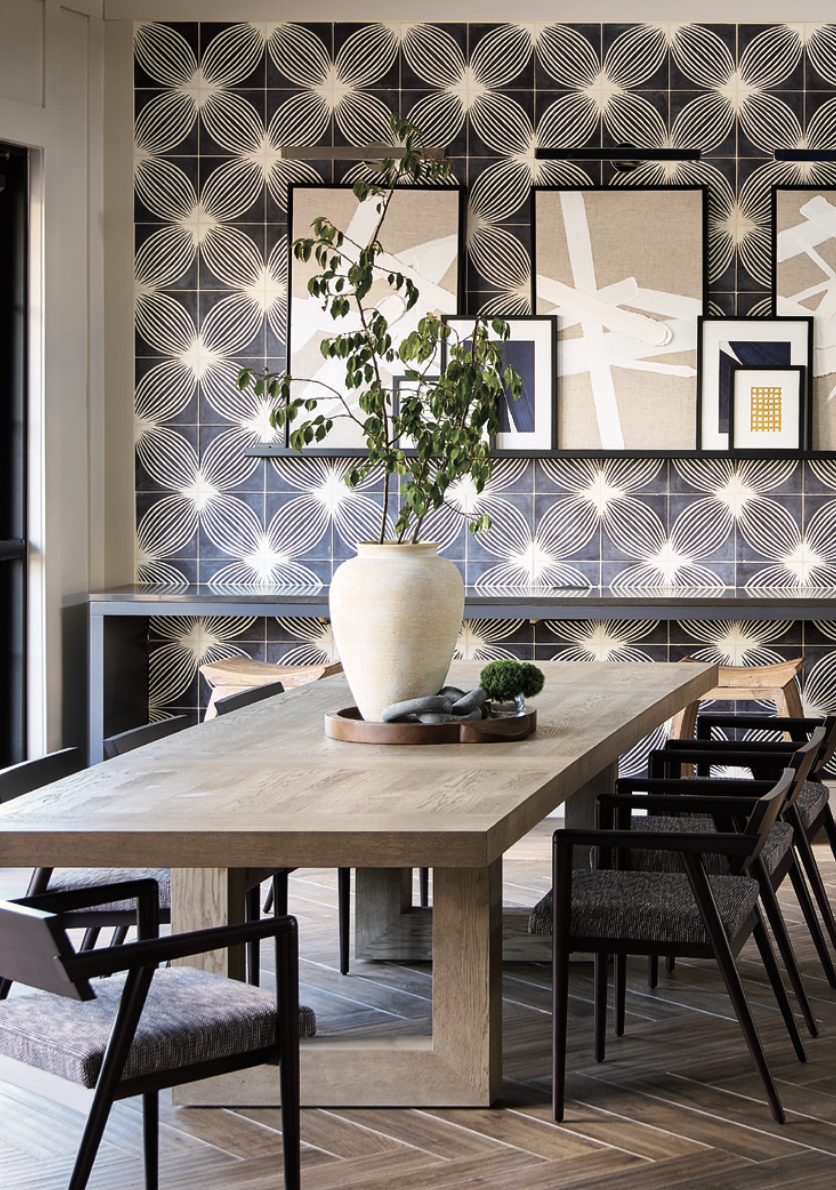
So much more than decorating
THE SEASONING THAT MAKES THE DISH
I watch a lot of cooking shows. It's amazing how world-class chefs know exactly what flavor combinations work. In cooking competition shows, one of the most common critiques that competitors get is, 'It's not seasoned properly.' Seasoning is that final element that enhances the flavors, pulls the dish together and takes it from 'good' to 'great.' It's part science, and part art.
The last of our Seven Fundamentals of interior design does a similar thing. Significant & Relevant Ornamentation is the final step, the seasoning, which elevates spaces and makes them truly great. It, too, is part science and part art.
Unfortunately, a lot of people, including some interior designers, think of this step as 'decorating.' They grab some pillows and pictures and call it a day. It may even look nice, but it's not nearly what it could be. To maximize the impact, let's take a look at what we're really talking about when we say, 'Significant & Relevant Ornamentation.'
What do they mean?
For something to be significant, it has to be great or important enough to be worthy of attention. To be relevant, it needs to have a connection to the history, people and culture of the those who will use the space. Or, to put it another way, you have to do the work. You have to immerse yourself in the sensibilities of the people you're designing for and curate your embellishments so they elicit the feelings you want from your audience.
Ornamentation is the final layer curated to complete the interior design of any room or space. With infinite options to consider, we typically start with vertical surfaces. Wall spaces detailed in pleasing proportions with strong background design call for accent or punctuation. They're a perfect host for framed art, framed mirrors, tapestries or even wall sconces. Horizontal surfaces including shelves, tabletops, or mantles, are more typically ornamented with objects such as boxes, books, pottery, bowls, and sculpture. Each of these elements works to elevate the composition and contributes in a critical way to the effect the space has on people. Since both framed art and objects used as accessories can be considered art in their own way, I want to take a deeper dive on 'art' itself.
Artists, art historians and philosophers all have something different to say about art. Aristotle wrote, 'The aim of art is to represent, not the outward appearance of things, but their inward significance.' Philosopher Richard Wollheim described art as 'one of the most elusive of the traditional problems of human culture.'
'The definition of art is open, subjective and debatable.'
– MARY COOK, FOUNDER AND PRESIDENT, MARY COOK ASSOCIATES
Since the first cave paintings, artists have pushed the boundaries of what defines art. The role of art – how it adds meaning to our lives – has also changed over the centuries. It continues to reflect reality, depict thoughts and feelings, and evoke beauty. While their agreement on the definition of art is lacking, all agree the art experience is vastly varied and complex.1
By comparison, ornamentation is simple. It lends grace, beauty or festivity. It's any additional detail that serves no other purpose than to make something more interesting, arresting, or beautiful to us.
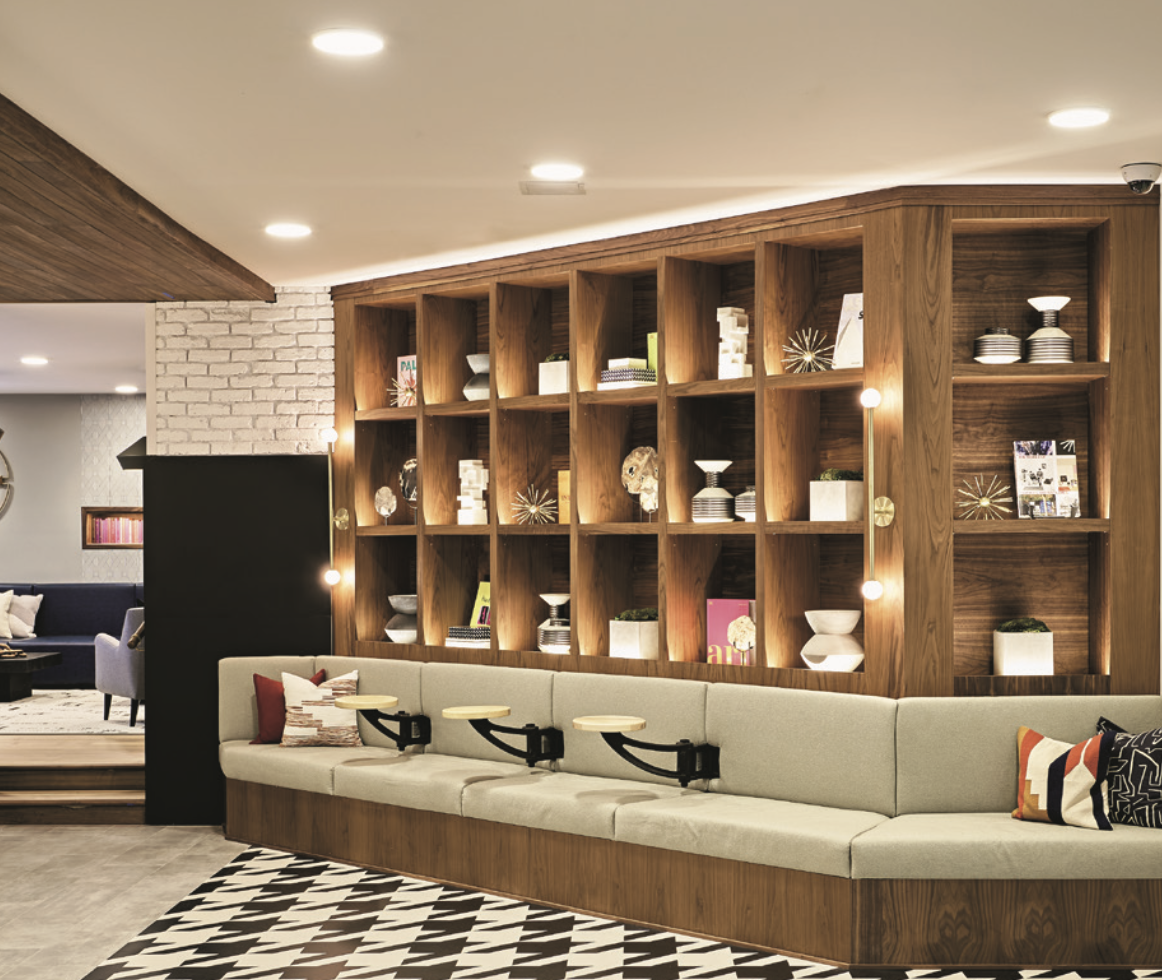
SHELVING ADORNED WITH UNIQUE OBJECTS, PATTERNS AND TEXTURES ENLIVEN THE LARGE WALL SPACE AT DEY & BERGEN IN HARRISON, NJ.
IT'S EVERYWHERE
A world of ornamentation
Ornamentation is everywhere. In music for example, added notes to a melody and variations in rhythm create a richer, more layered sound. Performers improvise to create new expressions of a piece.
Throughout history, ornamentation in architecture appears in various styles as embellishment to the design of buildings. It often occurs on columns and the tops of buildings, or around entryways and windows. It's also used as a line of demarcation between stories of a building. Contemporary architecture takes ornamentation to a new level with technology-driven materials and detail.
The Louis Vuitton Store on 5th Avenue in New York features an exterior adorned with glass depicting the brand's iconic checkered pattern. In the House of Industry in Copenhagen, neon lights situated on glass façades wrap the building with a continuous flow of changing colors.2 In both instances, enhancements serve no purpose other than to add interest and detail.
In landscape and garden design, art and ornamentation enhance beauty. Records from early American history indicate rockways, rills and rivulets were used as part of aesthetic ensembles. Bridges also took on ornamental roles in gardens.3
Garden ornamentation like bird baths add visual appeal in and of themselves while enhancing points of interest. They play a role in designing garden scenes while adding decorative accent. In a shady wooded corner, a small Japanese water basin called a 'tsukubai' enhances tranquility. Sundials complement herb and perennials gardens. Bamboo accents create a completely different kind of embellishment.
The existence of an ornament museum is testimony to the power of the art of embellishment. The Victoria and Albert Museum in London houses roughly 24,000 ornament prints, one of which dates back to the late 1700's. Ornament prints are a printed design or pattern and serve no other purpose than adding interest and beauty. The decoration adds absolutely nothing to the function, but the effect is certainly more appealing than plain white.
Armed with this knowledge, we can effectively put these tools to work.
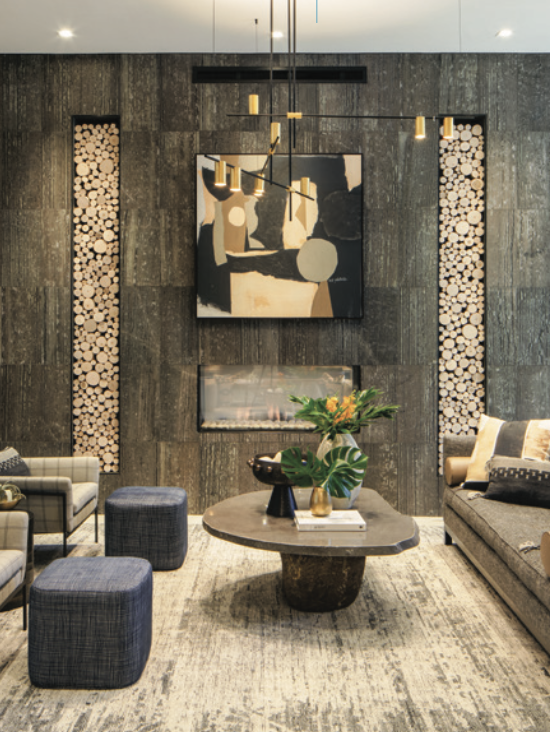
ECLECTIC ARTWORK, HISTORICAL PHOTOS, AND RICH TEXTURES BRING THE BUSTLING RAILROAD DAYS TO LIFE AT KILBY, AN OLD-WORLD, BRICK WAREHOUSE LUXURY STYLE APARTMENT COMMUNITY IN FRISCO, TX.
'If you ignore the complexity, you're in for big problems.'
– JOSH KASSING, SENIOR VP, MARY COOK ASSOCIATES
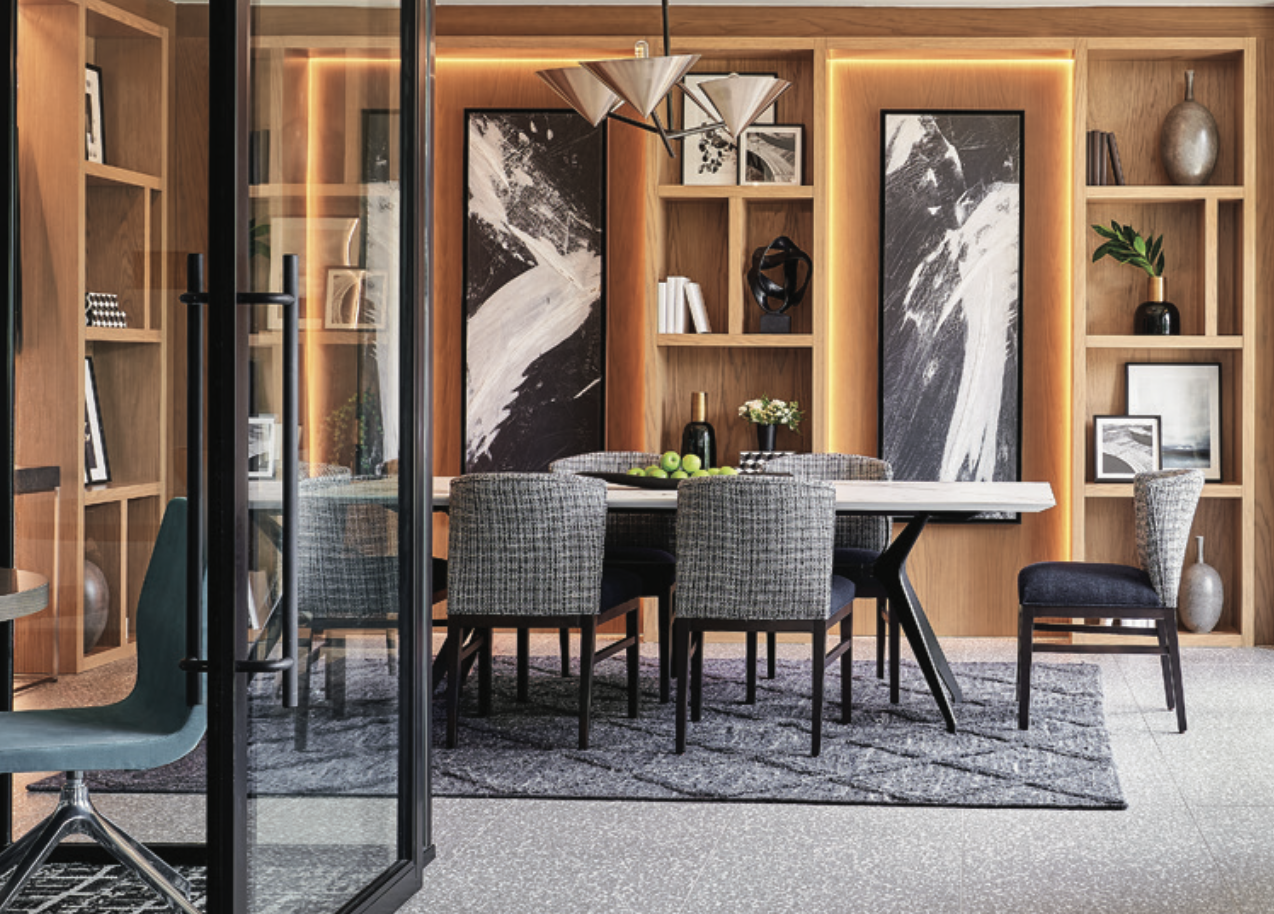
DRAMATIC FLOOR TO CEILING ARTWORK AT HATHON IN MEDWAY, MA DENOTES A CONTEMPORARY, SOPHISTICATED STYLE.
Living Proof
HAVE YOU EVER WALKED INTO A ROOM AND FELT THAT SOMETHING WAS MISSING?
Have you ever dressed for an important event and forgotten your earrings, cufflinks, or belt? It'll make you feel out of sorts for the whole evening. It was just a small detail though, so why should it matter so much? 'The devil is in the details' tells us that while something may seem simple, it's really more complicated.
The details of interior design are critical at each step, but this final layer is the seasoning that brings the entire composition into perfect harmony. Ornamentation punctuates the composition and elevates the experience to something visceral. You can see it. You can feel it. And It matters more than you probably realize. Without art and significant and relevant ornamentation, interiors would lose their ability to affect people in the many ways we know they can.
We first began to see just how important this final layer was back in 2008. As we began to realize there was something more to art and ornamentation than just aesthetics, a science began to emerge. That was the year the entire real estate market had come to a screeching halt.
But it didn't halt for us. We had more than 30 projects, including condominium developments, private clubs, restaurants, and single-family developments that called us in to fix or finish interiors that had just been completed by another designer.
'Something is missing.' 'Our members aren't relating.' 'We haven't sold a single one of these homes.' They couldn't put their finger on exactly what it was, but they knew something was off.
After our redesigns were completed, sales increased, prices increased, member activity increased, food and beverage spending increased; everything improved. People paid more for real estate. Club memberships went up. People were willing to pay more for hamburgers. They were more productive at work, and they became more active and social.
We had example after example of the impact of good interior design on the people who experienced it. And significant and relevant ornamentation, our seventh design fundamental working seamlessly with the other six fundamentals, was transforming underperforming spaces into interiors that delivered real measurable returns for our clients, over and over. Ornamentation was critical to the composition and without it, the interiors fell short. They were less inviting and had less impact on those who experienced them. They just didn't do what they were supposed to do.
When we published The Art of Space in 2015 and adopted the Seven Fundamentals as our proprietary approach to design, we knew it had incredible potential and that it mattered more than we knew. We began to track its effects both quantitatively and qualitatively. Accolades from developers who experienced quicker and more robust sales and leases, and feedback from residents describing how they felt in the spaces proved that our fundamentals delivered what we call R.O.E. or Return on Environment.
Why does it work?
There is no shortage of theories about what makes an object aesthetically pleasing. Ideas about proportion, harmony, symmetry, order, complexity, and balance have all been studied in great depth. Theories date as far back as 1876, in the early days of experimental psychology when German psychologist Gustav Fechner provided evidence that people prefer rectangles with sides in proportion to the Golden Ratio. If people value beauty and want to surround themselves with it and are willing to pay for it and pursue it, it must matter.
Now, after centuries of trying to understand and define beauty, scientists and psychologists are trying their hand at it as well. Today, scientists, psychologists, artists, and medical professionals are merging research, knowledge, and experience to formalize and promote Neuroaesthetics. This rapidly expanding field is aimed at the intersection of psychological aesthetics, biological mechanisms, and human evolution.
This transdisciplinary study of how the arts and aesthetic experiences measurably change the body, brain, and behavior, and how this knowledge is translated into specific practices that advance health and wellbeing, is advancing in leaps and bounds.
Maybe someday, research and studies in this area will give us a clear recipe for creating perfect spaces that get the perfect reaction. In the meantime, we have to rely on our experience, talent and instincts to meet our design goals.
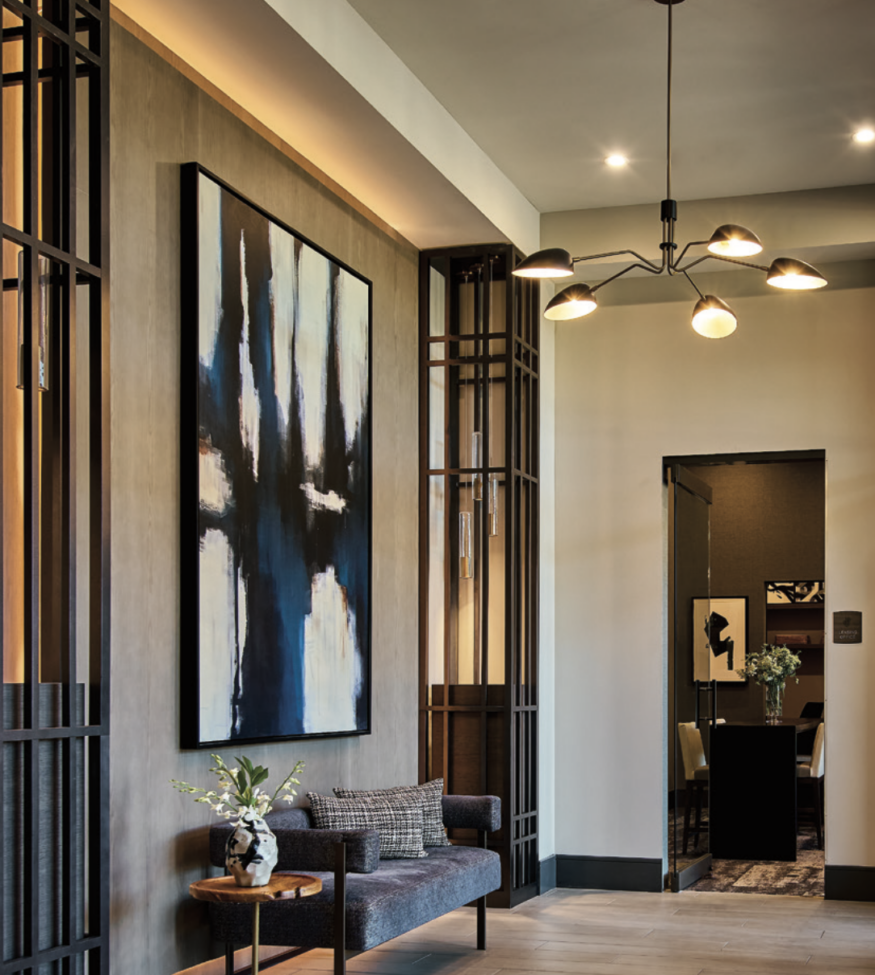
OVERSIZED ARTWORK CREATES AN ALLURING, BOLD STATEMENT IN THE LOBBY AT HIGHPOINT AT 8000 NORTH IN SKOKIE, IL.
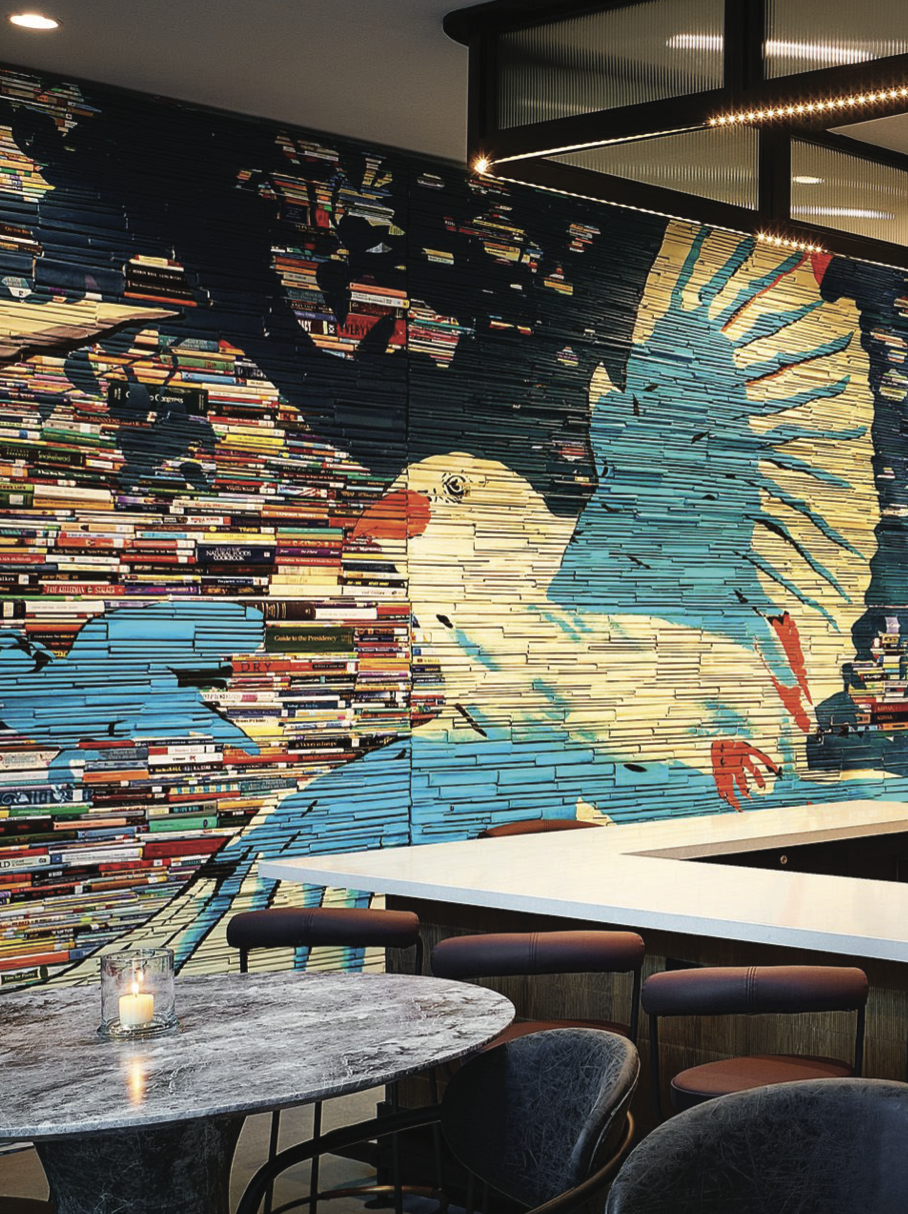
A BRANDED WALL DISPLAYING COLORFUL SPINES OF BOOKS AND TEXTBOOKS, ACCENTUATE THE COFFEEHOUSE AURA AT NOTION IN DECATUR, GEORGIA.
WE BASE IT ON A CLEAR UNDERSTANDING OF WHO WE ARE DESIGNING FOR
The beauty of it
We know that missing the layer of significant & relevant ornamentation can leave a space feeling cold and uninviting; too much ornament, ill-proportioned elements, or those that have no relevance just become clutter and leave a person feeling uncomfortable.
When we thoughtfully curate art and ornamentation for an interior design, we base it on a clear understanding of who we are designing for. We understand their demographic, geographic, and psychographic influences. And the interiors should pay homage to the architectural vernacular and local vibe.
Notion is a 290-unit luxury apartment community in Decatur, Georgia, 25 minutes outside Atlanta. Residents can walk to downtown Decatur, which hosts a variety of activities including Farmers Markets, festivals, and concerts in the park. The city is also filled with locally owned shops, bars, restaurants, and coffee shops. The development was inspired by the surrounding community, echoing the nearby neighborhood's historic industrial architecture. The interior design reflects Decatur's reputation, capturing the authenticity of the city's art and culture. Carefully selected ornamentation with significance and relevance to the target market including a branded wall displaying colorful spines of books and textbooks, accentuate the coffeehouse aura. Vintage radios and a phonograph displayed in a beverage bar are pleasing to look at while elevating social enjoyment in the space.
Dinuba, California is known for its rich agricultural roots and raisin production. When the City of Dinuba built Ridge Creek Golf Club, an award-winning 18-hole Public Premium course located in the heart of the central California valley, it included a full-service restaurant and bar, pro shop, and banquet facility. The California craftsman-style design of these spaces was inspired by the work of renowned local architecture firm Green and Greene, which was established in 1894. Throughout the interiors of the campus-style compound, authentic California craftsman-style millwork details were replicated from the firm's early work. Artwork and accessories were inspired by the local culture. Hand painted Kern River Trout by a local group of activists were framed and mounted together with a collage of hand-woven baskets from a local tribe of artisans. The reaction from the locals was pure delight as they completely engaged with the details.
Arizona State University is the most competitive student housing market in America. Understanding the mindset of the young adults attending the school and their parents helped to guide our use of ornamentation throughout the development of the interior of Canvas. Together with considerations around the geographic influences of Arizona's climate, we also incorporated our insights about Gen Z's values and priorities, current design trends, parental concerns and worries, and the university's intense tech-driven academic program paths. We used that knowledge in our design and selection of lively and relevant art and ornamentation to embellish experiences immersed in imagination and discovery.
Practicing the art of significant & relevant ornamentation is becoming more scientific every year. As we embrace new findings, we'll be adding them to our box of design recipes, seasoning our designs to perfection and serving them like comfort food to the people who experience them. As with most creative pursuits these days, it is part art, and part science.
Bon appetit!
GET THE PDF VERSION HERE
MEET THE AUTHORS

Mary Cook, Founder and President
Mary Cook is the founder and president of Mary Cook Associates (MCA), a fully integrated interior architecture and design firm nationally known for creating innovative interiors that are targeted to market demands, designed to increase property value and deliver measurable returns. The firm's projects for premier owners and developers of real estate include multi-family, model homes, student living, senior living, clubhouses, restaurants, and hospitality environments. Under Mary's leadership, the work MCA produces emphasizes functionality, showcases possibilities, and accelerates sales and leasing. Currently celebrating its 35th anniversary, the firm continues its national presence with award-winning work that spans 36 states.

Josh Kassing, Senior Vice President
Josh Kassing is Senior Vice President at Mary Cook Associates (MCA). In addition to overseeing MCA's Concept Studio and all design development, he provides leadership in client relationship management, business development, marketing, and the firm's expansion across national markets. With nearly a decade of design experience for domestic and international commercial, residential and hospitality projects, he is a regular go-to source for the industry. His contemporary perspectives have been featured in podcasts, Mansion Global, The Wall Street Journal, Builder & Developer, Multi-family Executive, Multi-Housing News, Globe Street and IIDA Perspectives. He is also a frequent presenter at industry conferences.
The final chapter.
Watch for OnSite – our latest look on real projects with real insights.
1. 'What is Art According to Famous Thinkers Through History,' https://www.widewalls.ch/magazine/what-is-art, June 13, 2016, Elena Martinique
2. 'Ornamentation in Contemporary Architecture,' Rethinking the Future,
https://www.re-thinkingthefuture.com/archi- tects-lounge/a819-ornamentation-in-contemporary-architecture/#:~:text=The%20word%20%E2%80%9Cornamentation%E2%80%9D%20simply%20means,artw ork%20to%20enhance%20its%20appearance
3. History of Early American Landscape Design, A Project of the Center for Advanced Study in the Visual Arts, National Gallery of Art National Gallery of Art, https://heald.nga.gov/mediawiki/index.php/Category:Garden_Ornaments/Embellishments


